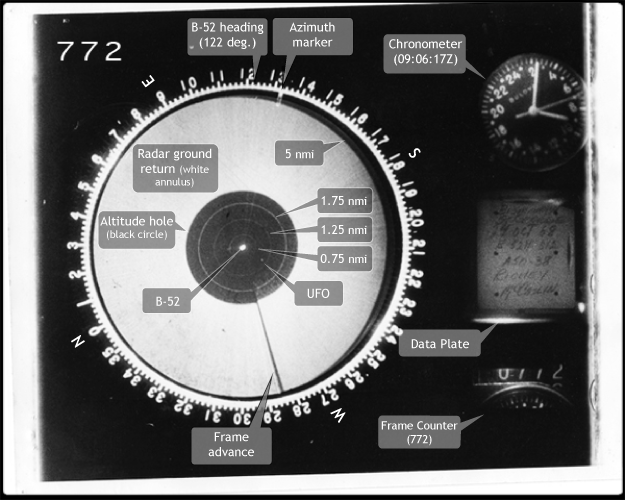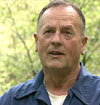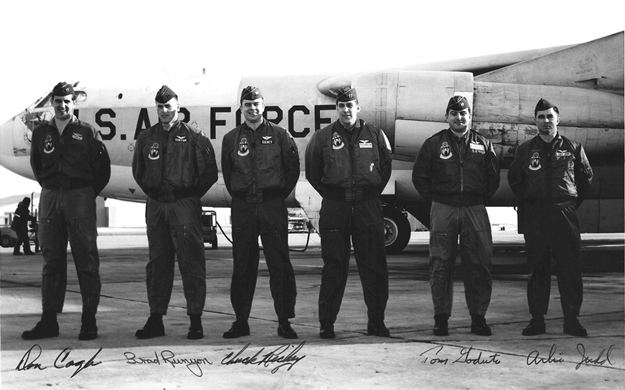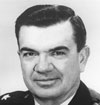 by Charles Lear, author of “The Flying Saucer Investigators.”
by Charles Lear, author of “The Flying Saucer Investigators.”
In Part I of this blog, we looked at a case from 1968 that involved sightings of a UFO on October 24, 1968, by ground observers stationed at the ICBM missile complex surrounding Minot AFB in North Dakota. A B-52 was flying in the area and the pilot was requested to change course and investigate. The result was a UFO encounter that was caught on photographs of the B-52 radarscope and the pilot, Maj. James A. Partin, and co-pilot, Captain Bradford Runyon, reported that they’d had a visual sighting of the object when it was on the ground. In addition to the sightings, it was reported that the outer and inner perimeter alarms of the missile site designated Oscar-7 went off and that a padlocked entry hatch there was found open with a plug-style gate secured by a padlock removed from it. The case was officially examined by the officer in charge of UFO investigations at the base, Lt. Col. Arthur Werlich. He provided details and evidence to Project Blue Book, and they concluded that what was seen was possibly a combination of “anomalous propagation” of radar returns, a plasma ball, and celestial bodies. They also concluded that the break-in was unrelated. The case lay dormant for 30 years until Runyon contacted the Center for UFO Studies and filled out a sighting report form. The case caught the interest of members of the newly formed Sign Historical Group and they did a thorough investigation that included many interviews with witnesses. They’ve made material they gathered available as part of the Sign Oral History Project on a website devoted to the case. In Part II, we’ll look at the key elements of the case that they uncovered.

On February 11, 2000, Bradford Runyon Jr., who was in the right front seat of the B-52 as a pilot-instructor at the time of the encounter, filled out a CUFOS UFO Sighting Questionnaire. According to his handwritten witness account, he requested permission to land at Minot (they had been in the air for about 10 hours) and was asked to check on something nearby. He was given a heading and when he asked what he was looking for he was told he’d know if he found it.
Shortly thereafter, an object appeared on the radarscope heading towards the right rear of the plane. It was moving at high speed, and the crew expected a collision, but it stopped by the right side of the plane and then moved to the left side. They lost radio contact with the base and Runyon made the decision to land. As they headed in, the UFO stayed with them for 10 miles and then broke off and landed. As it did so, their radios came back on. They were told to go back and fly over the object, and when they were over it, the radios stopped working again. Runyon wrote that the radarscope photos showed a return “about five times as large as a KC-135 tanker and a closing rate of 3000 mph.” According to him, people on the ground observed the object along with the plane. This account is close to the account in a Telex sent to Project Blue Book in 1968 by Werlich.
 There are poor quality reproductions of the radarscope photos in the Project Blue Book file that show something close to the B-52, and the SHG investigators were able to obtain higher quality prints from Richard Clark, who was a staff sergeant at Minot at the time of the incident. He had two sets up prints made when he was asked to analyze the photos and while he sent one set up the chain of command, he kept a set of 14 prints for himself. According to the investigators, he confirmed the account given by the B-52 crew and determined “that the speed (3900 mph at one point) and the maneuverability of the object were phenomenal.” According to him, “It had to be something other than what we were aware of, you know, I did not think our technology had anything like that as far as capability — so it’s got to be a UFO.” According to the B-52 navigator, Patrick D. McCaslin (USAF, Colonel, ret.), during a phone interview with SHG Investigator Jim Klotz, the return was as big or bigger than that of a KC-135 tanker plane.
There are poor quality reproductions of the radarscope photos in the Project Blue Book file that show something close to the B-52, and the SHG investigators were able to obtain higher quality prints from Richard Clark, who was a staff sergeant at Minot at the time of the incident. He had two sets up prints made when he was asked to analyze the photos and while he sent one set up the chain of command, he kept a set of 14 prints for himself. According to the investigators, he confirmed the account given by the B-52 crew and determined “that the speed (3900 mph at one point) and the maneuverability of the object were phenomenal.” According to him, “It had to be something other than what we were aware of, you know, I did not think our technology had anything like that as far as capability — so it’s got to be a UFO.” According to the B-52 navigator, Patrick D. McCaslin (USAF, Colonel, ret.), during a phone interview with SHG Investigator Jim Klotz, the return was as big or bigger than that of a KC-135 tanker plane.
One piece of information in Runyon’s account does not appear in the Blue Book file: according to him, he was told at a briefing the next day that a 20-ton lid over a missile silo had been moved. When he was interviewed on May 5, 2000, by SHG Investigators Thomas Tulien and Jan Aldrich, he went into more detail. He said he was told that an alarm had gone off at one of the missile silos and that Air Policemen were sent to check on it. When they didn’t check in, another team was sent. The second group found the first group unconscious around their vehicle, which had the paint on its roof burned off. When they came to, they said that an object came down that they thought was going to crush them, and they ran. Runyon told the investigators that the reason for the alarm was that the 20-ton cover had been moved. He said the chain link fence around the silo had been crushed, that there was radioactivity detected in the area, and that the alarm inside of the silo had been activated as well. Runyon told a similar story during a second interview with Tulien on February 25, 2005, that didn’t include the details about the crushed fence or the radiation.
The investigators were able to determine that the person who briefed the crew members was Brigadier General Ralph T. Holland. They managed to locate him and he was interviewed by Tulien and Klotz on February 20, 2005, just prior to Runyon’s second interview, after first being provided with material they’d gathered up to that point. Holland was 84 years old at the time and couldn’t recall some of the details, but he was sure that no 20-ton missile covers were moved. He told Tulien and Klotz, “Hell, if a lid had moved (laughs) SAC would’ve been down there in two seconds.”
Tulien mentions Runyon after confirming that Holland had read what the crew members said he told them and this exchange follows:

Holland: Yeah, he had the wildest damn story I—
Tulien: Now McCaslin was the navigator, he doesn’t remember as much as Runyon is remembering—
Holland: Yeah Runyon seemed like that he was remembering some things that he had gotten afterwards, you know.
Tulien and Klotz don’t bring up the incident involving the unconscious Air Police group and the burnt paint. Besides Holland, the investigators interviewed the four others who were at the briefing (one crew member, Aircraft Commander Capt. Don Cagle, was not present because he had an interview with Delta Air Lines the next day and wanted nothing to do with a UFO report) and none of them confirmed the details in question.
Runyon also included a description in the CUFOS form of the object seen on the ground by him as they flew over it. He drew a picture of an oval with an anchor-like shape coming off one end. He wrote that the body was “several hundred feet long” and glowed orange like molten steel. He describes that blue, green “and possibly orange lights” came from inside “the crescent moon shaped part.”
Maj. James A. Partin was the only B-52 crew member to fill out an AF-117 UFO report form for Project Blue Book, and on it, he described seeing what “looked like a miniature sun placed on the ground below the aircraft.” He made a tiny drawing of a circle he labeled “orange ball of light” with a faint rounded protuberance coming out the side marked “a very dim ring of soft white light.” During an interview with Klotz on January 20, 2001, he wasn’t able to recall any more details.
Patrick McCaslin, the navigator, recalled during his interview with Klotz on November 11, 2000, that when they flew over the object “there was an expletive from the top, and they
started describing this thing and asking if I wanted to come up and see it.” He said that afterwards someone, possibly Runyon, described the object to him as having an “elliptical shape, kind of a cough drop-shaped thing, glowing orange with a boomerang exhaust, or boomerang shaped exhaust or whatever, and fluorescence off one end the same color…” According to him, nobody saw the object in the air.
While Runyon may have been mistaken in some of his recollections or exaggerated some details, many aspects of the case are corroborated by multiple witnesses. The reports of the B-52 crew indicate that they did encounter something unusual and the radarscope photos provide strong evidence to back up their accounts. The other part of this story is what happened on the ground prior to their encounter.
Next week: The reports from the ground.
Podcast: Play in new window | Download